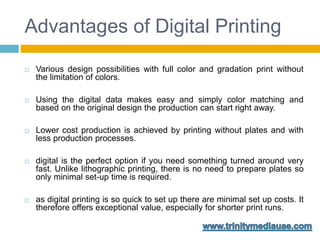3 Simple Techniques For Digital Printing
3 Simple Techniques For Digital Printing
Blog Article
An Unbiased View of Digital Printing
Table of ContentsThe 9-Second Trick For Digital PrintingSome Known Questions About Digital Printing.Some Of Digital PrintingDigital Printing Fundamentals ExplainedAn Unbiased View of Digital PrintingDigital Printing for Dummies
Variable information printing, such as straight mail with customized codes and addresses, is ideally suited for digital printing. Digital fast printing just requires four actions of design, testimonial, printing and binding to get every little thing done. Digital fast printing has an unparalleled benefit: print on need.According to PMMI, electronic printing permits brand names and makers to respond promptly to client demands while boosting the supply chain, decreasing warehousing expense and waste, and delighting in faster time to market. That all noises fantastic, yet just how does this innovation do all that? The major differentiator of these technologies is that there are no set up charges and no plates with electronic printing.
About Digital Printing
This results in quicker turnaround time and reduces cost when using electronic printing.
Digital printing is extremely adaptable, so it's easy to make modifications to the plan design quickly. It all goes back to the plates.
With conventional printing methods, short-run printing is just not feasible. Because a terrific design can make or damage your product, electronic printing consistently creates top notch, clear and colorful graphics each time.
Digital printing is the process of printing digital-based images straight onto a variety of media substratums. There is no requirement for a printing plate, unlike with countered printing. Digital data such as PDFs or desktop computer posting files can be sent straight to the electronic printing press to print on paper, photo paper, canvas, textile, synthetics, cardstock and various other substratums.
The Single Strategy To Use For Digital Printing
According to PMMI, electronic printing enables brands and manufacturers to respond swiftly to consumer demands while improving the supply chain, lowering warehousing cost and waste, and enjoying faster time to market. That all sounds wonderful, yet how does this modern technology do all that? The major differentiator of these modern technologies is that there are no set up fees and no plates with digital printing.
According to Wikipedia, the best difference in between digital printing and traditional approaches such as lithography, flexography, gravure, or letterpress is that there is no requirement to replace printing plates in digital printing, whereas in these analog printing approaches home plates are continuously replaced. This results in quicker turn-around time and lowers price when utilizing digital printing.

9 Easy Facts About Digital Printing Described
More supply can indicate more waste down the roadway. With conventional printing techniques, short-run printing is simply not possible. Due to the fact that an excellent design can make visit the site or damage your product, electronic printing continually creates high-grade, clear and vivid graphics each time. Digital printing on adaptable bags adds the brilliant, vivid, and accurate graphics that virtually bid consumers to connect and touch them.

According to PMMI, electronic printing allows brands and suppliers to respond rapidly to consumer demands while enhancing the supply chain, lowering warehousing cost and waste, and appreciating faster time to market. That all sounds wonderful, however just how does this technology do all that? The major differentiator of these innovations is that there are no set up costs and no plates with digital printing.
The Ultimate Guide To Digital Printing
According to Wikipedia, the biggest difference between digital printing and conventional techniques such as lithography, flexography, see gravure, or letterpress is that there is no need to replace printing plates in digital printing, whereas in these analog printing methods the plates are repetitively changed. This leads to quicker turn-around time and reduces cost when using digital printing.
Digital printing is very flexible, so it's easy to make adjustments to the bundle design rapidly. It all goes back to the plates.

The Best Strategy To Use For Digital Printing
Digital printing is the procedure of printing digital-based pictures straight onto a range of media substratums. There is no demand for a printing plate, unlike with balanced out printing. Digital files such as PDFs or desktop computer posting data can be sent out directly to the electronic printing press to print on paper, image paper, canvas, material, synthetics, cardstock and various other substratums.
Report this page